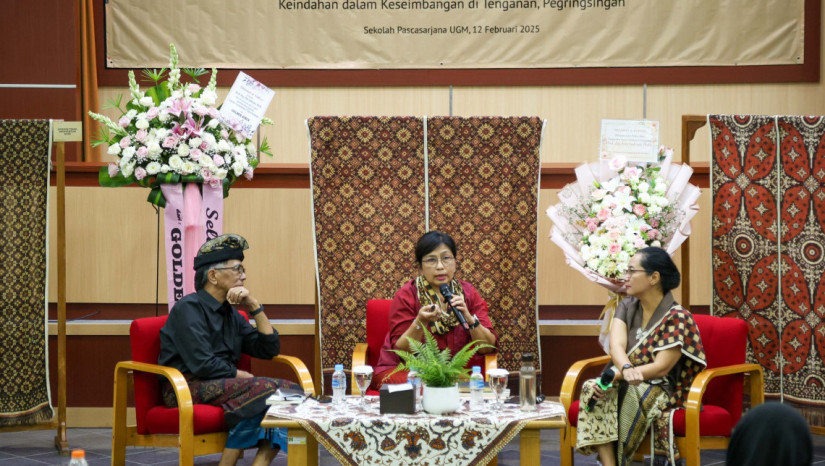
UGM anthropologist Professor Etty Indriati launched her book “Vitality of Gringsing Weaving in Bali: Beauty in Balance in Tenganan Pegringsingan” on Wednesday (Feb. 12) at the 5th-floor Auditorium of UGM Graduate School.
During the launch event and the Gringsing Weaving Discussion and Exhibition, several Gringsing weaving collections were displayed, allowing attendees and visitors to admire their beauty.
Professor Indriati shared the story behind her decision to write the book, which stemmed from a batik exhibition held in the United States in 2017.
“In 2017, I was invited to identify batik at The Art Institute of Chicago,” she explained.
At that time, she was tasked with distinguishing various types of batik and their origins, such as batik Solo, batik Cirebon, and batik Yogyakarta, among others.
Her collection was also showcased there. The five-month exhibition sparked her curiosity, leading her to begin researching the fabric, tracing its origins to Bali.
She explained that in its place of origin, the local community uses Bali’s Gringsing Cloth as a religious material to express their beliefs and build religious experiences.
This is evident from its close association with local rituals.
“So, my conclusion after visiting Bali is that Gringsing is a cultural material used to express religious expression,” she said.
It is used for various purposes, such as a sarong, offerings, swings symbolizing balance, a child’s first haircut ceremony, and the Pandan War Ritual.
Professor Indriati also explained the meaning behind several Gringsing weaving motifs, including the Wayang Kebo motif, which is considered the most sacred and worn by Rejang dancers in Tenganan Pegringsingan.
She further described how the designs of Gringsing weaving follow a symmetrical concept called isometric in mathematics.
In relation to the surrounding community, Gringsing weaving tells how the local community protects their customary forests.
Despite technological advancements, she observed that cultural and religious rituals within the community remain intact.
“When we protect the forest, there is a green economy and ecological sustainability; it doesn’t get destroyed, nor do the people become poor. This is the land that must be preserved,” she stated.

Professor Indriati explained the lengthy process of creating Gringsing cloth, which takes years. Young unmarried girls learn how to weave Gringsing and are placed in dormitories where they must sleep on straw until they find their soulmate.
Another unique aspect of the Gringsing weaving process is that it must follow an orderly and correct sequence, similar to how religious rituals must be performed in a specific order and cannot be skipped.
“What amazes me is that the rituals must follow a sequence and continue until the girl develops a sense of devotion,” she said.
The Rector of Universitas Gadjah Mada, Professor Ova Emilia, expressed her appreciation for Professor Indriati’s book launch.
According to Professor Emilia, this book serves as an excellent medium to promote culture and tradition as a national identity. It aligns with Universitas Gadjah Mada’s role as a cultural center and continuously supports academic efforts in cultural preservation.
“In this book, Professor Indriati tries to depict how Gringsing weaving represents the harmony of life and reflects the cultural identity of the Balinese people,” she remarked.
Author: Leony
Editor: Gusti Grehenson
Post-editor: Afifudin Baliya
Photographer: Donnie

